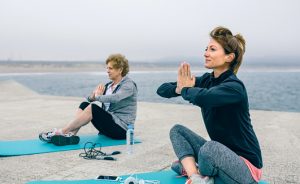Triangle, warrior, mountain: these words create a fairly clear visual that leaves little to the imagination. However, when you mix in these three words with the words down dog, lotus, and eagle, perhaps, a completely new image forms. These words are all specific postures that a person would do while practicing yoga. Merriam-Webster’s Dictionary defines yoga as a system of physical postures, breathing techniques, and sometimes meditation derived from (the Hindi Philosophy) Yoga but often practiced independently, especially in Western cultures, to promote physical and emotional well-being. As June 21st is International Yoga Day and the first day of Summer, this seemed like the perfect opportunity to share the second article of the self-care and wellness series.

Though yoga has only been in the West for around two centuries, it has a history that spans over 2,000 years. The origins of the modern yoga stem from the Yoga-Sutras, or teachings, of the Indian scholar Patanjali. In the Yoga-Sutras Patanjali summarized yoga as an eight-limbed-path that offered guidelines to living a purposeful and meaningful life. These eight limbs are:
- (yama) or ethical standards: people should live by to cause no harm.
- (niyama) or personal disciplines: including self-study, cleanliness, and dedication to god.
- (asana) or the postures: develop discipline in the sacred temple of the body
- (pranayama) or breath control: practicing conscientious breathing to rejuvenate the body.
- (pratyahara) or worldly detachment: focus on the self by getting rid of outside distraction.
- (dharana) or concentration: focusing on a single subject mentally for an extended time.
- (dhyana) or meditation: developing a meditated state where one is aware without focus.
- (samadhi) or the state of bliss: transcending the self and connecting with the Divine.
The connection between these eight parts helps lay the foundation for society’s current understanding of the mind, body, and spirit connection.
 Many individuals in the behavioral health field and similar helping professions give so much of their time and effort to their cause and clients that they can forget about their own needs. There is great evidence in both peer reviewed articles and personal reflection confirming this unfortunate truth. Excess stress, compassion fatigue, and burnout are just three such examples of things that affect health care professionals when they don’t spend a sufficient amount of energy on their individual needs. The Oxford Dictionary defines self-care “as the practice of taking an active role in protecting one’s own well-being and happiness, in particular during periods of stress.” On the surface this definition is quite simple to understand, but like many other things putting the wisdom into practice is much more challenging. Yoga offers a great start in actively bettering the self.
Many individuals in the behavioral health field and similar helping professions give so much of their time and effort to their cause and clients that they can forget about their own needs. There is great evidence in both peer reviewed articles and personal reflection confirming this unfortunate truth. Excess stress, compassion fatigue, and burnout are just three such examples of things that affect health care professionals when they don’t spend a sufficient amount of energy on their individual needs. The Oxford Dictionary defines self-care “as the practice of taking an active role in protecting one’s own well-being and happiness, in particular during periods of stress.” On the surface this definition is quite simple to understand, but like many other things putting the wisdom into practice is much more challenging. Yoga offers a great start in actively bettering the self.
To better understand the flow of a yoga class and the connections between yoga and self-care I interviewed a local yoga teacher, Kelli Grock, on her views on yoga. Mrs. Grock described yoga as a full body practice that uses a combination of poses, meditation and breathing techniques to bring awareness to the moment. She elaborated that yoga’s unique integration of the mind and body invites the practitioner to notice the important little things that usually are missed in the chaos of everyday life. What is learned on the yoga mat can be directly translated to real life. An article published in the Nursing Forum explained the process of a yoga class along a similar vein as Mrs. Grock. The article said that while practicing postures, participants “pay attention to lengthening the spine, linking movement with breath, and placing awareness on what is experienced in the body in each moment.” As the mind and attention wanders during the action (which is normal) individuals attempt to return that focus to an awareness of the breath, the specific movement, and the moment. With time and consistent practice yoga improves strength, stamina, flexibility, balance, and helps the body better relax.
 Mrs. Grock described several benefits she recognizes from yoga, but do Scientific Journals back up her claims on the benefits of yoga? A review article on the effects of Yoga on Mental and Physical Health from the Journal on Evidence-Based Complementary and Alternative Medicine found that “yoga may have potential to be implemented as a beneficial supportive/adjunct treatment that is relatively cost-effective, may be practiced at least in part as a self-care behavioral treatment, provides a life-long behavioral skill, enhance self-efficacy and self-confidence.” On a smaller scale a study called Yoga for Self-Care and Burnout Prevention Among Nurses found that the 20 nurses in the yoga intervention group showed significant improvement in selfcare and mindfulness, and experienced less emotional exhaustion, and depersonalization outcomes compared to the control group. While there aren’t 1,000s of perfectly conducted studies explaining the exact science of yoga, a 2,000-year history must have some merit that yoga is valuable.
Mrs. Grock described several benefits she recognizes from yoga, but do Scientific Journals back up her claims on the benefits of yoga? A review article on the effects of Yoga on Mental and Physical Health from the Journal on Evidence-Based Complementary and Alternative Medicine found that “yoga may have potential to be implemented as a beneficial supportive/adjunct treatment that is relatively cost-effective, may be practiced at least in part as a self-care behavioral treatment, provides a life-long behavioral skill, enhance self-efficacy and self-confidence.” On a smaller scale a study called Yoga for Self-Care and Burnout Prevention Among Nurses found that the 20 nurses in the yoga intervention group showed significant improvement in selfcare and mindfulness, and experienced less emotional exhaustion, and depersonalization outcomes compared to the control group. While there aren’t 1,000s of perfectly conducted studies explaining the exact science of yoga, a 2,000-year history must have some merit that yoga is valuable.
What does someone do in a yoga class that translates to self-care in the real world? Everyone understands that exercise is beneficial and that activities like push ups make a person stronger and stretching makes a person more flexible. Over the long run these types of activities definitely improves a person’s physical well-being; however, Emily Lockhart, a yoga teacher since 2006, explained some more subtle benefits of yoga in her article 9 Self Care lessons that Yoga teaches. Her nine lessons are:
- Let things Go
- Reveal inner strength
- Relaxing is hard work
- Listen to the body
- Treat yourself with kindness
- There is no perfect standard in yoga
- Practice reaps rewards
- Negative Criticism is Futile
- We all have limits—and that’s OK.
While these are only a few of the potential lessons a person can take from Yoga, they are a great place to start. The lesson that I felt resonated most with self-care was the importance of listening to the body. During long work weeks the body often knows when things are not quite right, and rest or some kind of change is needed. However, deadlines or difficult cases can make listening to the body’s feedback challenging. In yoga its recommended that a person takes a posture only to a point of resistance, but not into pain. During class the teacher and other students do not know that specific point in your specific stretch; only by listening to the body does a person know that limit and not push their body too far. Over time that limit may expand or shrink, and every day may be a slightly different experience. Understanding this feedback in the body then can translate to things outside of yoga.
Self-care is a vital topic for all individuals, especially those in the behavioral health field. Like laughter, yoga can be a useful means to giving oneself the little extra care needed to help live that healthy and balanced life. From enhancing flexibility, building strength, and practicing mindful breathing to accepting one’s personal abilities and limitations, yoga allows an individual to take the active role in improving his or her well-being. Yoga is such an expansive topic that this single article barely scratches the surface on its value. More information on yoga can be found in the self-care learning lab and the resources section. Several CASAT courses also share how yoga can be incorporated into work as a form of treatment that helps improve lives. We send you to the rest of your day the same way as all yoga classes conclude: with the simple phrase, Namaste.

This article is really informative for us. Yoga is a group of physical, mental, and spiritual practices or disciplines which originated in ancient India. It is a practice of body and mind with 5000 years of history in ancient Indian philosophy. Yoga became popular as a form of physical exercise based upon its unique style and advantages along with improved control of the mind and the body. This article is really helpful for us. Thank you so much for such a crucial article.
Jennifer, glad you found the post informative. And you are right, yoga is an excellent form of self-care!